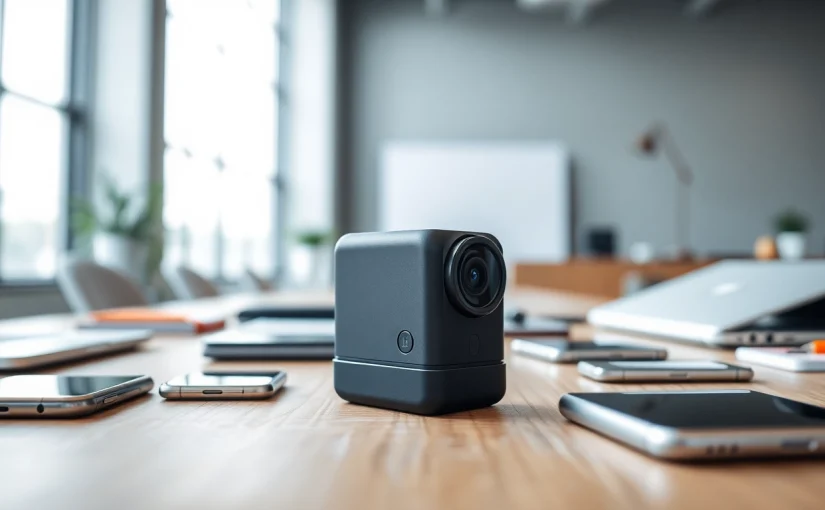Introduction to AdMob vs Google Ads
As the digital advertising landscape continues to evolve, businesses must navigate various platforms to ensure successful marketing campaigns. Among the prominent offerings from Google are AdMob and Google Ads, both essential in their respective fields. Although they serve different purposes, understanding how to leverage each platform effectively can significantly enhance your advertising strategy. In this article, we’ll delve into a comprehensive comparison of admob vs google ads, exploring their features, functionalities, monetization strategies, and much more.
Overview of AdMob and Its Purpose
Google AdMob is a mobile ad network specifically designed for app developers who want to monetize their mobile applications. Launched in 2010, AdMob serves as a bridge connecting app developers with advertisers, allowing them to earn revenue by displaying ads within their apps. Through various ad formats such as banner ads, interstitials, and rewarded video ads, developers can choose how to monetize their applications while providing value to users. AdMob stands out for its emphasis on mobile screens, enabling developers to target audiences on-the-go effectively.
What is Google Ads and Who Uses It?
Google Ads, formerly known as Google AdWords, has a broader reach and is utilized by a diverse range of businesses to promote products and services across the web. From local startups to multinational corporations, companies leverage Google Ads to create various ad formats, including search ads, display ads, video ads, and shopping ads. Google Ads allows businesses to reach users at different stages of their buying journey, targeting them based on keywords, demographics, geographic locations, and even browsing behavior.
Key Similarities and Differences
While both AdMob and Google Ads are integral components of Google’s advertising ecosystem, they cater to different audiences and have distinct purposes. AdMob focuses primarily on app monetization by displaying ads within mobile applications, whereas Google Ads serves broader marketing goals aimed at driving traffic to websites or promoting products and services across various online platforms.
A fundamental similarity lies in the data-driven nature of both platforms; each leverages advanced analytics to track performance, optimize campaigns, and enhance user engagement. Understanding these nuances will help businesses and developers determine which platform aligns better with their advertising goals.
Comparative Analysis of Features
Target Audience and Use Cases
The target audience for each platform significantly shapes its functionality. AdMob is specifically tailored for mobile developers looking to monetize their apps effectively. It allows them to reach users within various apps, leveraging in-app advertising to enhance user experience while generating income. Use cases for AdMob typically involve companies with mobile applications seeking to diversify their revenue streams through advertising integrations.
Conversely, Google Ads caters to businesses seeking to enhance their online presence through website traffic or generating leads. Companies can use Google Ads to promote special offers, drive website visits, and establish brand awareness. The versatility in ad placements—across search results, video platforms like YouTube, or third-party websites—makes Google Ads suitable for various marketing campaigns.
Monetization Strategies in AdMob vs Google Ads
The monetization strategies differ significantly between AdMob and Google Ads. In AdMob, developers can generate income through a myriad of ad formats. Banner ads can be displayed at the top or bottom of the app screens, while interstitial ads offer full-screen ads that users encounter during transitions between app states. Rewarded video ads incentivize users to engage with advertisements in exchange for virtual rewards within the app, striking a balance between ad effectiveness and user satisfaction.
In contrast, Google Ads focuses on driving conversions and traffic. Advertisers can utilize different bidding strategies based on their objectives—be it maximizing clicks, impressions, or conversions. Whether through text, image, or video ads, businesses can tailor their campaigns to align with specific marketing goals, enabling ad placements that resonate with the target audience’s context. This flexibility allows businesses to invest advertising spend efficiently based on campaign performance.
Performance Metrics and Reporting Tools
Performance measurement is critical for optimizing ad campaigns. Both AdMob and Google Ads come equipped with robust reporting tools that can help track key performance indicators (KPIs) such as impressions, clicks, click-through rates (CTR), and revenue generated. AdMob’s reporting analytics provide developers with insights about ad performance, user engagement, and geographic performance, allowing them to make data-driven decisions on ad placements and formats.
Google Ads, on the other hand, provides comprehensive analytics dashboards reflecting campaign performance across various metrics. Tools like Google Analytics and Google Tag Manager can be integrated to provide deeper insights into user behavior, allowing advertisers to tweak their campaigns for better results. Understanding these performance metrics is vital for both app developers and businesses, as it aids in refining their advertising strategies to meet objectives effectively.
Best Practices for Using AdMob
Setting Up AdMob for Mobile Apps
Getting started with AdMob requires a strategic setup process. Developers first need to create an AdMob account and link it to their mobile applications. The integration involves using the AdMob SDK to implement ad formats seamlessly. Also, ensuring compliance with policies and best practices outlined by Google is essential in maintaining ad quality and optimizing monetization efforts.
When setting up, developers should categorize target audiences based on demographics, interests, and behavior. Utilizing mediation networks in addition to AdMob can further enhance revenue by accessing multiple ad networks and filling gaps in inventory. Careful ad placement should ensure that ads are not intrusive, maintaining a positive user experience that encourages users to continue engaging with the application.
Maximizing Revenue with AdMob
To maximize revenue using AdMob, developers should experiment with different ad formats and placements. For instance, interstitial ads can yield higher revenue but may disrupt user interactions if overused. Establishing a balance between user experience and revenue generation is critical. Furthermore, leveraging AdMob’s mediation feature can help access additional ad inventory, leading to increased fill rates and revenue potential.
Developers should also regularly analyze performance reports to understand which ad types and placements yield the best results. A/B testing various creatives and ad formats can help identify the most effective combinations for revenue generation. Keeping abreast of industry trends and ad technologies can also inform adjustments that lead to better performance outcomes.
Common Pitfalls to Avoid
Several common pitfalls can hinder a developer’s success with AdMob. One prevalent mistake is not adhering to ad policy guidelines, which can lead to account suspensions or bans. Another issue arises from poorly optimized Google AdMob integration; overlooking the user experience can lead to app deletions rather than ad engagement.
Additionally, failing to monitor and analyze performance data regularly may prevent developers from identifying underperforming ads or placements. Developers should commit to continuous learning about best practices and industry standards. Leading practices such as keeping ad frequency reasonable and ensuring ads are relevant can significantly enhance user satisfaction and profitability.
Best Practices for Google Ads
Creating Effective Google Ads Campaigns
Creating effective campaigns in Google Ads starts with setting clear goals. Advertisers must define what they wish to achieve, be it brand awareness, lead generation, or product sales. Once goals are established, choosing the right campaign type—whether search, display, or shopping—is essential to align objectives with ad placements.
Furthermore, crafting compelling ad copy can significantly impact click-through rates. Advertisers should create headlines that captivate the audience’s attention, complementing them with engaging descriptions. Including strong calls to action (CTAs) can urge users to take the desired action, enhancing conversion prospects.
Keywords and Targeting Strategies
Keywords form the backbone of successful Google Ads campaigns. Conducting thorough keyword research helps identify terms that potential customers are searching for, enabling advertisers to capture the right audience effectively. Employing tools like Google Keyword Planner can inform decisions on keyword selection, competition levels, and projected costs.
Targeting strategies play a vital role in ensuring ads reach the right audience. Segmenting campaign audiences based on demographics, interests, and behaviors can enhance targeting precision. Retargeting ads based on previous user interactions with a website or product can further improve conversion rates. Creating audience lists to refine targeting approaches may also contribute significantly to campaign success.
Measuring Success with Google Ads
Measuring success in Google Ads involves monitoring multiple metrics to evaluate performance. Key outcomes include CTR, conversion rates, cost per acquisition (CPA), and return on ad spend (ROAS). Regularly assessing these metrics provides insights into what strategies are working and which areas require refinement.
Utilizing tools like Google Analytics in conjunction with Google Ads can provide deeper insights into on-site user behavior. This integration allows advertisers to track the customer journey, enabling adjustments to both ad campaigns and landing page experiences to align more closely with user expectations.
Conclusion: Which is Right for You?
Evaluating Your Marketing Goals
Choosing between AdMob and Google Ads ultimately depends on your marketing goals and the nature of your business. If your primary objective is to monetize a mobile application, AdMob offers tailored solutions that specifically cater to app developers. However, should your focus lean towards general digital marketing campaigns designed to drive traffic and conversions through diverse ad placements, Google Ads may be the more suitable option.
Choosing Between AdMob and Google Ads
Consider your target audience and advertising objectives when determining a platform. If you are an app developer focused strictly on in-app advertising, AdMob is your go-to solution. If you are a business looking to boost brand visibility or drive product sales across the web, Google Ads presents a versatile option for achieving your goals.
Future Trends in Online Advertising
The future of online advertising will likely be shaped by advancements in machine learning and predictive analytics, enhancing how businesses target their audiences and optimize campaigns. A potential rise in augmented reality (AR) advertising may also redefine user engagement experiences, particularly on mobile platforms. Staying informed about these emerging trends will help advertisers take advantage of their opportunities, using both AdMob and Google Ads to enhance their overall advertising performance.

